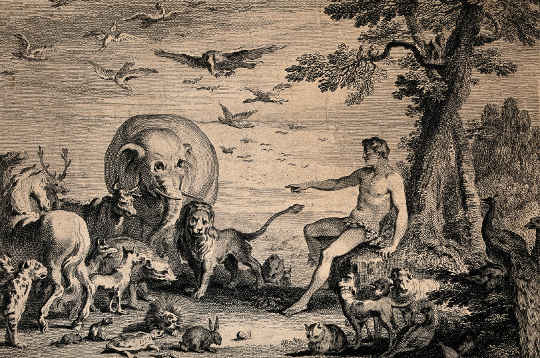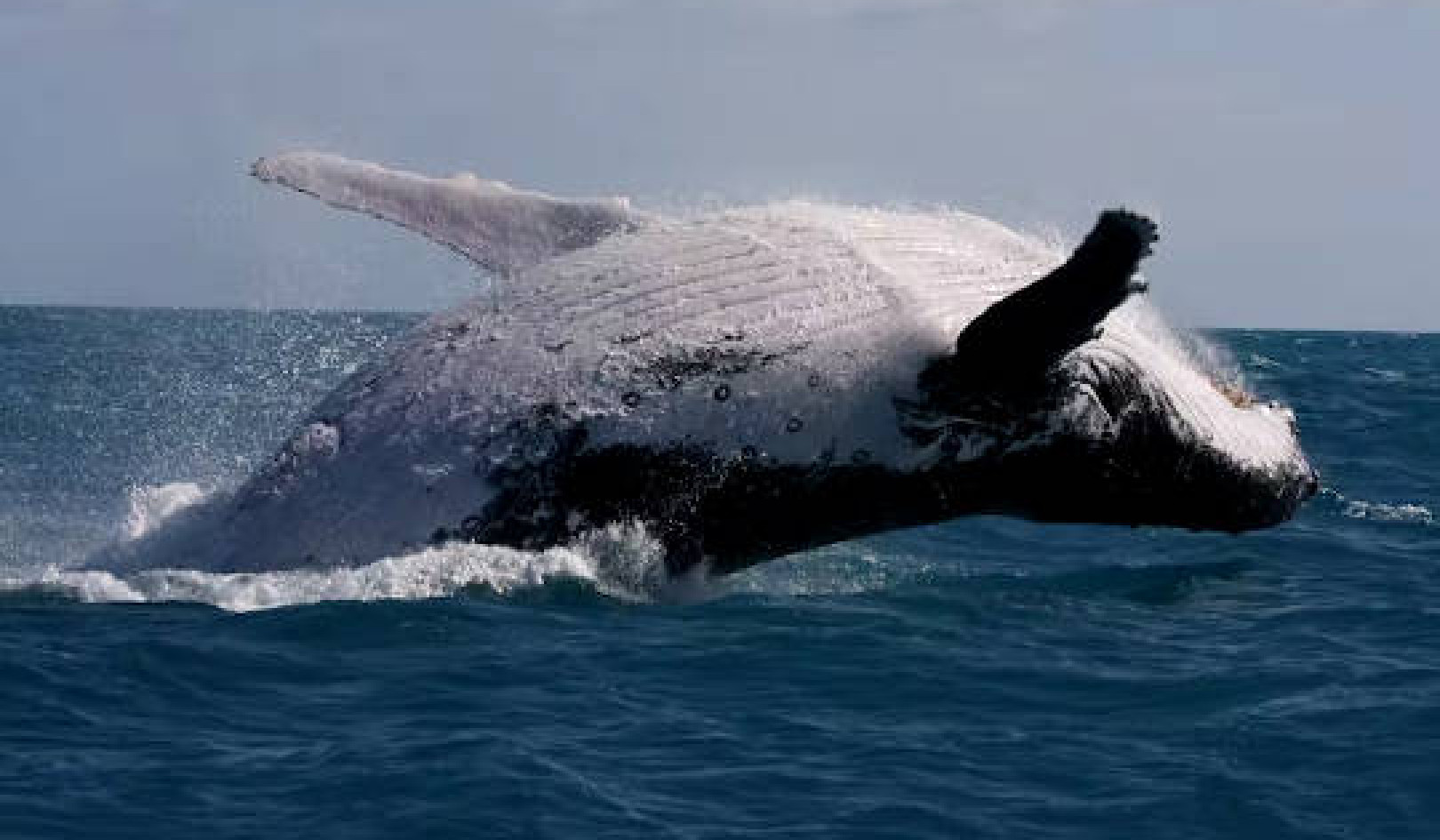
Adam naming the animals. Etching credits: Wellcome. (cc 4.0)
In the 1990s, many of the equestrians I encountered believed that animals were incapable of thought and emotion. “It’s all instinct,” one of my trainers told me whenever I brought up anecdotal evidence to the contrary. Some of the local ranchers insisted that, unlike dogs, horses weren’t smart enough to recognize their own names.
Even when a Thoroughbred, quarter horse, Appaloosa, or Arabian had a registered name, it was considered a convenient way to link valuable breeding stock to their ancestors on paper. If a cowboy at one of these operations wanted someone to catch a few geldings in the back pasture, he’d distinguish them by color or marking, saying something like, “Hey, go get the black, the line-back dun, and that chestnut with the two white socks.”
Over the years, I met a number of unregistered cow horses who had never been given names. I questioned this practice once, simply by mentioning that my mare came when I called her, and two grizzled ranch hands looked at each other, rolled their eyes, shook their heads, and smirked. “You feed her, don’t you?” one asked. I nodded. “That’s not her name working for you; that’s her stomach,” he replied.
When I mentioned that horses are commonly taught vocal commands like “walk,” “trot,” and “giddy up,” the other argued that this was “conditioning.” Horses, these men insisted, weren’t conscious enough to have an actual identity, and so naming them was superfluous, something that riders did for their own amusement.
Call Them By Name
Since that time, the popularity of the natural horsemanship movement has changed more than a few cowboy minds. Well-known, Stetson-clad clinicians travel the country introducing training techniques that take the mental and emotional fitness of both horse and rider into consideration. But the idea that a wild animal might respond to a name is still up for debate in many circles.
Even Joe and Leslye Hutto, authors of Touching the Wild, who called pack rats (also known as woodrats) out of hiding for hand-fed treats, weren’t sure that mule deer would be able to distinguish their names, especially after they left the ranch for summer grazing that first year. As the does returned the following September, however, the Huttos were pleased that the deer not only remembered their two-legged friends, new fawns trusted the couple more quickly as a result.
As it became clear that the doe, Rayme (short for Doe-Ray-Me) had probably met with a tragic end, every doe that walked onto the property was cause for celebration. When Notcha (named for “a distinct notch taken out of her left ear”) arrived, the Huttos were thrilled and relieved. However, she was also traveling with some new companions. As these much more skittish deer caught sight of Joe standing in the yard, they turned in fear and began trotting toward the mountains. As Joe described:
Leslye exclaimed through the glass, “Say her name! Quick.” I called in a loud voice, “Notcha!” Then I repeated, “Notcha!” To our absolute astonishment, Notcha stopped and turned, staring momentarily, and, then, leaving the other deer, ran — yes, ran — at a gallop directly to me. We were stunned at the revelation that she not only recognized my voice and knew exactly who I was after six months without doubt, but, even more amazing, recognized her name!
Following Notcha’s example, the other deer soon joined us for a few minutes of casual greetings that included a few horse cookies. I returned to the house astonished. Why on earth would a wild deer have the capacity to so readily recognize and retain the oral association of some name that had been assigned to her in a previous year?
I began to wonder how that particular kind of identification could be included in the deer’s repertoire of social possibilities — and why. It was at that moment that I began asking a question that still haunts me: “Who am I actually dealing with here, and what are the possibilities?”
The Bonding Process
Even now, pastoral tribes are much more likely to name their animals than sedentary farmers. But this unexpected anecdote from the Huttos suggests that naming may have been an important part of the ancient bonding process that allowed herbivores and humans to trust each other, move together, and eventually live together.
Even though animals don’t have the vocal capacity to name us, they appear to appreciate it when we name them. Perhaps in the act of naming, human beings break through a haze of skepticism, objectification, and anthropocentric self-absorption to recognize the unique qualities and potential of each and every individual.
Back in 1982, when mainstream scientists insisted that animals were unintelligent, purely instinctual beings, philosopher Vicki Hearne went through all kinds of intellectual contortions to challenge this mechanistic perspective. Her book, Adam’s Task: Calling Animals by Name, feels a bit dated, especially in the wake of the Cambridge Declaration on Consciousness. But when Bazy Tankersley, founder of the respected Tucson breeding operation Al-Marah Arabians, introduced me to this book in the mid-1990s, I practically fell to my knees and wept tears of gratitude.
Hearne mixes anthropological, historical, and religious references with her own experiences as a dog and horse trainer. She argues that while we gained technological expertise through the process of civilization, we lost something important in distancing ourselves from other living beings. “Typography,” a word she uses to describe humanity’s tendency to generalize and categorize, “made possible further gaps between us and animals, because we have become able to give them labels, without ever calling them by name.”
Depersonalizing or Typecasting Humans?
Over the centuries, we’ve generalized this practice to other humans as well. My colleague Juli Lynch said to me, “I’ve seen so much depersonalizing of people in organizations, even to the extent where someone is referred to by his job duty versus his name. I’ve worked with banks that had only thirty to forty employees, and the CEO did not know everybody’s name — not because he couldn’t remember that many names, but because it wasn’t important to him. Employees knew it didn’t matter to him. And guess what: The company’s turnover rate was exceptionally high for a small-town employer where jobs were not easy to find.”
The case for correcting this dehumanizing behavior becomes all the more poignant when you realize that calling an animal by name is important to forming effective working relationships with our four-legged friends. Unlike the cowboys I mentioned earlier, Hearne insists that “training horses creates a logic that demands not only the use of a call name...but also...the making of the name into a real name rather than a label for a piece of property, which is what most racehorses’ names are.” As the title of her book suggests, she believes that “deep in human beings is the impulse to perform Adam’s task, to name animals and people as well.” She emphasizes that we need to take this ancient art form seriously by choosing “names that give the soul room for expansion.”
Hearne contends that naming our animal companions links us back to an earlier form of consciousness that modern humanity lost when we moved from oral tradition to writing or literacy. Linguistic anthropology, she reports, “has found out some things about illiterate peoples that suggest” they used “names that really call, language that is genuinely invocative,” rather than our current culture’s overemphasis on “names as labels.” The author cites a lecture she attended with an anthropologist who was captivated by the “surprising” perspectives that certain “illiterate languages” reveal:
One of his stories was about an eager linguist in some culturally remote corner trying to elicit from a peasant the nominative form of “cow” in the peasant’s language.
The linguist met with frustration. When he asked, “What do you call the animal?” pointing to the peasant’s cow, he got, instead of the nominative of “cow,” the vocative of “Bossie.” When he tried again, asking, “Well, what do you call your neighbor’s animal that moos and gives milk?” the peasant replied, “Why should I call my neighbor’s animal?”
Ultimately, Hearne writes, she is “not arguing against advances in culture, only pointing out that it is paradoxically the case that some advances create the need for other advances that will take us back to what we call the primitive” (italics added). I would further emphasize that when early conquerors began to objectify, corral, and eventually enslave both animals and people, our literate civilization not only lost sight of the real power of naming, it relinquished the nomad’s sophisticated understanding of leadership through relationship. This was knowledge that came directly from partnering with animals who maintained active social lives.
Treating People Like Machines?
Modern leaders all too often treat people more like machines than sentient beings. In this respect, civilization has “evolved” in an unproductive direction. Resurrecting the knowledge of ancient pastoralists is crucial to shifting this demoralizing trend.
This becomes especially clear in studying the Huttos’ example. Joe and Leslye didn’t scientifically habituate a herd of mule deer. The couple formed meaningful relationships with receptive individuals who initiated a level of contact they were comfortable with. As a result of the respectful, highly responsive behavior Hutto and his wife exhibited, they progressively gained the interest and trust of a wider mule deer network.
Far too many leaders try to amass power by controlling groups of people, but that only works with disempowered populations (people who relinquish their potential gifts through fear and mindless conformity). Forming alliances with free, intelligent, creative adults requires a different approach: cultivating an expanding network of relationships with individuals who are recognized — and valued — for their unique talents, skills, and personalities.
Rayme and Notcha represented the auspicious start of the Huttos’ seven-year journey naming well over two hundred individuals with recognizable faces, markings, and distinct personalities. If Joe and Leslye had lived a few thousand years earlier, they may very well have left what would have been a primitive grain-producing settlement and followed their adoptive herd mates on summer migrations, swinging back around to the Slingshot Ranch valley just in time for fall harvest. In the process, the human element would have been in better position to protect the many does, fawns, and bucks who died due to accident or predation during those migrations.
Expanding Our Horizons And Collaborating With Strangers
In the lives of many twenty-first-century humans, an ancient pattern is once again repeating itself, calling attention back to an earlier curve in the great spiral of evolution, that time when increasing mobility, freedom, and mutual aid grew out of a fertile period of sedentary development. During that first cycle, times of plenty, boosted by prehistoric agricultural and technological innovations, provided food, water, safety, and camaraderie. This in turn encouraged some people to expand their horizons and collaborate with strangers who orbited around these settlements; strangers who were not shy about moving to greener pastures during heat, drought, and other compromising weather conditions.
Strangers like Notcha, who felt the sincerity of a tenuous attraction and became friends with people who reached out, recognized her uniqueness, and called her by name.
©2016 by Linda Kohanov. Used with permission of
New World Library, Novato, CA. www.newworldlibrary.com
Article Source
 The Five Roles of a Master Herder: A Revolutionary Model for Socially Intelligent Leadership
The Five Roles of a Master Herder: A Revolutionary Model for Socially Intelligent Leadership
by Linda Kohanov.
Click here for more info and/or to order this book.
About the Author
 Linda Kohanov, the author of the bestseller The Tao of Equus, speaks and teaches internationally. She established Eponaquest Worldwide to explore the healing potential of working with horses and offer programs on everything from emotional and social intelligence, leadership, stress reduction, and parenting to consensus building and mindfulness. Her main website is www.EponaQuest.com.
Linda Kohanov, the author of the bestseller The Tao of Equus, speaks and teaches internationally. She established Eponaquest Worldwide to explore the healing potential of working with horses and offer programs on everything from emotional and social intelligence, leadership, stress reduction, and parenting to consensus building and mindfulness. Her main website is www.EponaQuest.com.

























